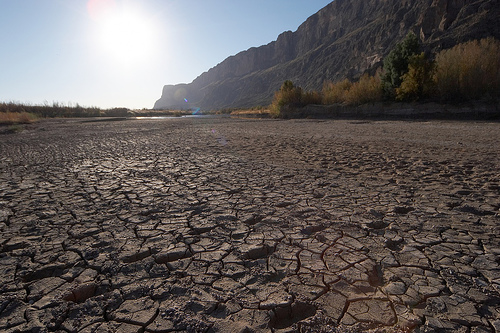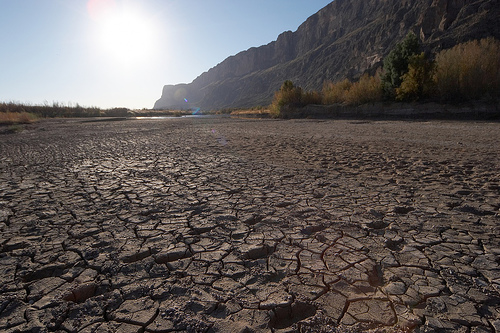 Drought denial’s tougher to pull off than climate denial.Photo: Luke RobinsonWhere and how will climate change first affect large numbers of American voters? Answering that question may be crucial to the global efforts to protect the Earth’s climate. The tsunami of stupidity and science denial that has washed over Washington, D.C., won’t be held back by earnest calculations of long-run risks, or by the potential inundation of remote island nations, or by the news that polar bears and other iconic species are endangered.
Drought denial’s tougher to pull off than climate denial.Photo: Luke RobinsonWhere and how will climate change first affect large numbers of American voters? Answering that question may be crucial to the global efforts to protect the Earth’s climate. The tsunami of stupidity and science denial that has washed over Washington, D.C., won’t be held back by earnest calculations of long-run risks, or by the potential inundation of remote island nations, or by the news that polar bears and other iconic species are endangered.
While climate change may seem remote, the water crisis in the Southwest is all too immediate. Recent years of drought have reached critical levels, threatening to curtail agriculture and even the normal patterns of urban life throughout the region. Even if today’s climate remained unchanged, water use in Arizona, California, Nevada, New Mexico, and Utah would more than double over the next century, just from population and income growth.
In a recent study, Elizabeth Stanton and I show that the changing climate will make a bad situation worse, increasing the Southwest’s water consumption by an additional one-third of today’s level of use. There is simply no way to get that much water; the region’s rivers and rainfall aren’t going to grow. Ocean desalination is expensive, energy-intensive, and environmentally controversial. Groundwater, which makes up the water deficit today, is bound to run out at some point; it is being used far beyond its recharge rates in California and Arizona, and probably elsewhere as well. There are two different estimates of California’s current groundwater reserves; the state would need three times the more optimistic estimate in order to make it through the next century.
Solving the water crisis will require reductions in water use. Nevada and Utah are the top two states in per capita residential water use today. Extensive conservation and efficiency measures will be needed, reshaping urban water use, improving irrigation methods, and cutting back on the region’s lowest-value crops, which are worth less than the water used to grow them.
It gets much harder to solve the water crisis when it gets hotter: We found that climate change could add as much as $1 trillion to the costs of water scarcity for the five Southwestern states over the next century. As Americans start to experience mounting costs of climate change in this and other areas, spending money to reduce carbon emissions will look like a bargain by comparison.
So here’s a message from planet Earth to our newly elected congressional “leaders.” You’ve made it clear that you’re not planning to protect the climate because of what’s happening to polar bears, or the islands that are sinking beneath the waves, or even because you care about the lives of your great-grandchildren. But you’ve got to take action anyway; controlling climate change is crucial if you want people to have reliable water supplies in the Southwest. This isn’t the only way that you’ll feel the impacts of climate change in years to come — but it could be the first big one.



